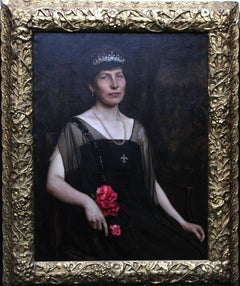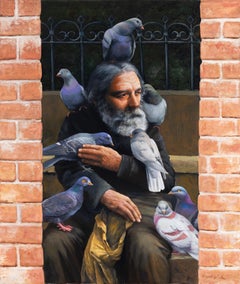Ralph Peacock Art
Ralph Peacock was a painter and illustrator born in Wood Green, London on August 14th, 1868. He was trained as a civil servant, but when he was 18 years old, he took art classes at the Lambeth School of Art, attending twice a week in the evenings. John Pettie saw one of his portraits and was so impressed he recommended that Peacock should take up painting professionally. Following his advice, Peacock attended the St John's Wood Art School, where he stayed for a year and then in 1887, he was admitted to the Royal Academy Schools. Peacock would have been familiar with all the famous contemporary artists of the period such as Sir Frank Dicksee, Lord Frederic Leighton, William Holman Hunt, Edward Burne-Jones and Herbert Draper. It was a common practice for artists to exchange models and Mary Lloyd, a professional artist's model, sat for Leighton and Alma Tadema and was introduced to Peacock by Herbert Draper. Peacock painted her in A Study of 1896. Peacock was also good friends with J.W. Godward. The influence of these artists on Peacock in his early years was very strong, and he won a Gold Medal and traveling scholarship from the Royal Academy for his historical painting Victory. He also won the Creswick prize. From 1890, Peacock also did book illustrations, signing his rather lively wash drawings with a flourishing signature or sometimes just 'R.P.' In 1892, he traveled around the Mediterranean and Switzerland. He exhibited his works, winning medals in Vienna in 1898 and Paris at the Exposition Universelle in 1900. By this time, Peacock's main interest was portraiture and he made his career as a very successful portraitist. Holman Hunt was among his sitters but he specialized in elegant society portraits of ladies and children. A double portrait called The Sisters is in the collection of the Tate and Peacock painted this in 1900. The elder of the two girls, Edith Brignall became his wife and they lived with their two sons in Wimbledon. He eventually moved to Camden and died there on January 17th, 1946. Peacock exhibited many society portraits at the Royal Academy and elsewhere and this charming picture is a fine example of the artist's genre. While illustrations by Peacock are widely distributed in the magazines of the day, including Punch, paintings by him are hard to find other than in public collections.
Early 1900s Realist Ralph Peacock Art
Oil
2010s Realist Ralph Peacock Art
Canvas, Oil
Robert Kenneth WhiteRobert Kenneth White "Sanctuary in Feathers" Large Figurative Oil Painting, 2018
Late 19th Century Realist Ralph Peacock Art
Oil
2010s Realist Ralph Peacock Art
Oil, Canvas
Late 19th Century Realist Ralph Peacock Art
Oil
2010s Realist Ralph Peacock Art
Oil
Mid-19th Century Realist Ralph Peacock Art
Canvas, Oil
2010s Realist Ralph Peacock Art
Canvas, Oil
21st Century and Contemporary Realist Ralph Peacock Art
Canvas, Oil
2010s Realist Ralph Peacock Art
Canvas, Oil
Mid-19th Century Realist Ralph Peacock Art
Oil
Early 2000s Realist Ralph Peacock Art
Canvas, Oil
Early 2000s Realist Ralph Peacock Art
Canvas, Oil
1920s Realist Ralph Peacock Art
Oil
1890s Pre-Raphaelite Ralph Peacock Art
Oil


